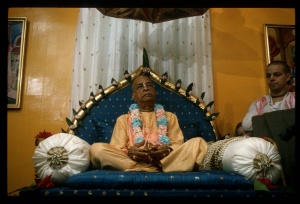BG 13.6-7 (1972)

A.C. Bhaktivedanta Swami Prabhupada
TEXTS 6-7
- महाभूतान्यहंकारो बुद्धिरव्यक्तमेव च ।
- इन्द्रियाणि दशैकं च पञ्च चेन्द्रियगोचराः ॥६॥
- इच्छा द्वेषः सुखं दुःखं संघातश्चेतना धृतिः ।
- एतत्क्षेत्रं समासेन सविकारमुदाहृतम् ॥७॥
- mahā-bhūtāny ahaṅkāro
- buddhir avyaktam eva ca
- indriyāṇi daśaikaṁ ca
- pañca cendriya-gocarāḥ
- icchā dveṣaḥ sukhaṁ duḥkhaṁ
- saṅghātaś cetanā dhṛtiḥ
- etat kṣetraṁ samāsena
- sa-vikāram udāhṛtam
SYNONYMS
mahā-bhūtāni—great elements; ahaṅkāraḥ—false ego; buddhiḥ—intelligence; avyaktam—the unmanifested; eva—certainly; ca—also; indriyāṇi—senses; daśa ekam—eleven; ca—also; pañca—five; ca—also; indriya-gocarāḥ—objects of the senses; icchā—desire; dveṣaḥ—hatred; sukham—happiness; duḥkham—distress; saṅghataḥ—the aggregate; cetanā—living symptoms; dhṛtiḥ—conviction; etat—all this; kṣetram—field of activities; samāsena—in summary; sa-vikāram—interaction; udāhṛtam—exemplified.
TRANSLATION
The five great elements, false ego, intelligence, the unmanifested, the ten senses, the mind, the five sense objects, desire, hatred, happiness, distress, the aggregate, the life symptoms, and convictions-all these are considered, in summary, to be the field of activities and its interactions.
PURPORT
From all the authoritative statements of the great sages, the Vedic hymns and the aphorisms of the Vedānta-sūtra, the components of this world are earth, water, fire, air and ether. These are the five great elements (mahābhūta). Then there are false ego, intelligence and the unmanifested stage of the three modes of nature. Then there are five senses for acquiring knowledge: the eyes, ears, nose, tongue and touch. Then five working senses: voice, legs, hands, the anus and the genitals. Then, above the senses, there is the mind, which is within and which can be called the sense within. Therefore, including the mind, there are eleven senses altogether. Then there are the five objects of the senses: smell, taste, warmth, touch and sound. Now the aggregate of these twenty-four elements is called the field of activity. If one makes an analytical study of these twenty-four subjects, then he can very well understand the field of activity. Then there is desire, hatred, pleasure and pain, which are interactions, representations of the five great elements in the gross body. The living symptoms, represented by consciousness and conviction, are the manifestation of the subtle body-mind, ego and intelligence. These subtle elements are included within the field of activities.
The five great elements are a gross representation of the subtle false ego. They are a representation in the material conception. Consciousness is represented by intelligence, of which the unmanifested stage is the three modes of material nature. The unmanifested three modes of material nature is called pradhāna.
One who desires to know the twenty-four elements in detail along with their interactions should study the philosophy in more detail. In Bhagavad-gītā, a summary only is given.
The body is the representation of all these factors, and there are changes of the body, which are six in number: the body is born, it grows, it stays, it produces by-products, then begins to decay, and at the last stage it vanishes. Therefore the field is a nonpermanent material thing. However, the kṣetrajña, the knower of the field, its proprietor, is different.